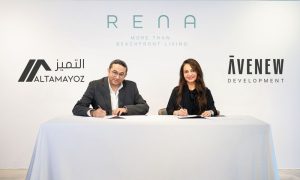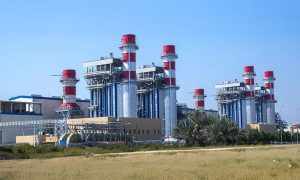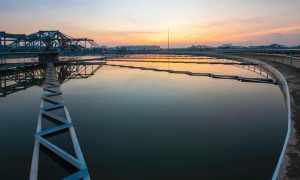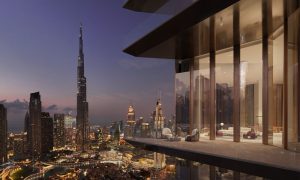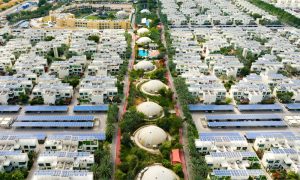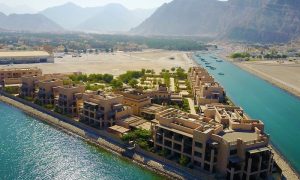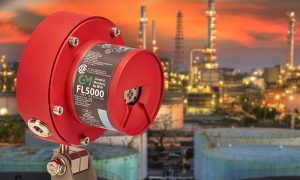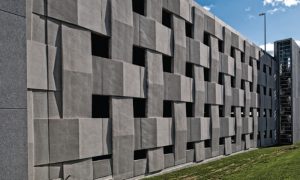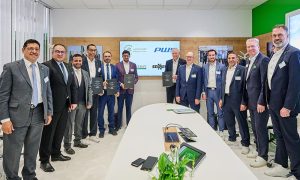Tapping Opportunities
Representatives from three of the region’s most prominent bathroom suppliers speak to The Big Project about the latest technology and the trends driving its adoption

Did you face any issues when building the prominence of your brand in the region?
Mohammed Nada: Depending on the market, the Kohler brand has been here between 30 and 50 years. We are prominent in the luxury market and more of the A+ and A++ clients know our products. We have US and European product lines, both of which are demanded in the region. The European brand began gaining recognition around a decade ago as a trend for contemporary and modern design evolved.
Overall it depends on the country. In Saudi Arabia, ARAMCO demands US standards are adhered to, so the US range is popular. In other markets, like the UAE, the European range is more popular.
Our diversity of products has empowered us to satisfy a lot of needs within the specifications of both US and European standards.
Nick Baker: Being a UK-based company holds a lot of weight here. We are working with some of the same issues in the UK as here in regards to water solutions and reducing consumption. We are bringing our knowledge to the region, for example by meeting the stringent Estidama guidelines using our expertise from meeting the Sustainable Homes targets in the UK. With regards to design, many of the trends come from the UK, US and Europe, so we are very much on the cutting edge. We have already launched a range of new products, such as digital taps and showers; considered to be the taps of the future.
If you try to dazzle people with various techniques to measure consumption, those who are not in the industry or who do not fully understand how it works do not fully utilise them”
Ben Brydon: Since 1995 we have evolved our business knowing the companies we were supplying were going to take on lower and lower costs. In 2000 we developed into a luxury one stop shop by taking on some major brands, allowing us to target interior designers and grow a reputation for being an ‘interior designer’s tool box’.
All the difficulties we face in terms of pricing and deliveries we have overcome with a relatively large portfolio of products, catering to a wide market sector. We have started developing our own brands and an own-brand range called Bagno Design, targeted to the hospitality midsector of the market.
In terms of construction trends, how has your company responded to the change in focus between hospitality, residential and mega projects?
[facts]
The Panel
Nick Baker, Export Specifications Manager, Vado
Ben Brydon, Sales Director, Sanipex
Mohammed Nada, Marketing Manager, Kohler
[/facts]
NM: We have continually catered to all these divisions by pushing new products and designs. Currently we are witnessing a trend for water saving products, which we have been able to promote very well throughout our regional operations in America. We have then incorporated these elements into personalised designs, which are stylish and unique. We work with our local designers and R&D departments around the world and a full range of products was launched last year.
NB: We are very lucky because we are specialists; we do branch out into accessories and that is very much where we are looking to divert in future. We serve everything from the very lowend products, to the trade market, throughout the world. We also do the middle ranges, which are used in low to middle-cost hotels, and then we have our high end products for more luxury driven hotels.
We have noticed that while the projects and business markets are declining, there has been a massive jump in retail sales as people upgrade their houses instead of moving”
BB: We have evolved by targeting the residential and commercial sectors, which are less design driven. The hospitality industry is much more unique in terms of requirements and we have a portfolio of products encompassing everything from the basics to the intricate designs of presidential suites. One of our key areas for growth over the next few years will be institutions such as schools, places of worship; places not only in the UAE but in other markets, too. We are developing a product range that covers ADA requirements and British standards to meet these specifications.
Following the cancellation of ISH in Dubai due to “market sentiment”, how significant are trade fairs in this region for your particular sector?
BB: There are probably only two or three significant fairs- The Big 5, The Hotel Show and Index. Unfortunately few shows are organised by product type, so you have bathroom items next to trucks and you have to know what you want to find, particularly in the biggest shows.
MN: We participated in ISH Dubai in 2008, but today there are other fairs where we can showcase our products, such as Wetex. At this year’s show we had good exposure for our water saving products.
NB: As an evolving company, Vado is always looking at and launching new products and we have a presence at the shows which we think will fit our products well. We are always adding to our catalogue and fairs provide a great arena to gauge what is working.
BB: Shows are important to communicate company news, new products and trends. But they are only successful if you can back it up by having a good showroom in which to showcase those products afterwards — otherwise the brand isn’t recognised.
MN: The need for specific kitchen and bath shows is essential. Cityscape covers real estate, The Hotel Show is hospitality, The Big 5 hosts all the suppliers; having a specific kitchen and bath shows is important for architects, designers, contractors, developers and other suppliers to come together and see all the products.
Have you witnessed any emerging demand trends during recent trade exhibitions?
The need for specific kitchen and bath shows is essential. it is important for architects, designers, contractors, developers and other suppliers to come together”
BB: What we noticed this year at ISH in Germany was the advancement in technology. Everybody is showcasing water saving products and pioneering very different ways of using water in faucets and showers. Additionally, people are looking for a very different look in bathrooms. Fewer chrome or ‘hard’ designs, in favour of platinum, nickel and bronze; a much calmer way of creating an environment and more of a spa feeling.
MN: We use the opportunity to demonstrate our products; the comparison of low flush and high flush toilets, our infrared technology, the hybrid battery, waterless urinals and so on. The feedback is always good because we see people from municipalities, hospitality, designers from all over the world. It’s a good platform, specifically for showcasing the waterless technology, which is gaining popularity.
NB: One benefit is being able to demonstrate a shower which reduces output to nine litres a minute and still performs well. Being able to physically show that to somebody is very good. I think it’s natural to find the best trade shows to be at in the region.
How has the trading landscape changed recently and how has this affected your operations?
MN: We have a strong range of products across all our markets. While not all our diversifications (see box) are applicable to the Middle East yet we do hope to migrate them to other markets, but we will do that in response to the emerging conditions in each individual market.
BB: We regard ourselves as a customer orientated supplier, and develop products and services based on their needs. This helps us to offer extra services to the customers including designs, training programmes for contractors, service contracts with hotels and maintenance contracts to ensure products are living the life they are intended to.
In addition to these demands, we have also witnessed particular change in the trading landscape over the last three years. However, we have noticed that while the projects and business markets are declining, there has been a massive jump in retail sales as people upgrade their houses instead of moving.
We have also noticed a big difference in trade to our wholesale markets, Saudi Arabia and Qatar. There has been a paradigm shift in power in our organisation.
NB: As the market has changed we have opened a regional office to enhance our focus and serve the whole Middle East and Africa; all of these regions have massive potential for us. As a family run company from Somerset, England, we are not on the same scale as Kohler quite yet, but we have different initiatives that we continue to push. For example, with regards to global water conservation we are now looking at different ways to achieve what the authorities are asking us to, for example by developing grey water systems.
On the flip side of that you can still see the luxury market as being a major market for our company. These are interesting times.
Are there any particular elements of the new environmental legislation in the region which pose strong opportunities for your operations?
MN: We have already captured this market in the US and won an award last year. Per capita consumption in Abu Dhabi is the highest in the world and the resulting legislation has given Kohler an opportunity to market our hybrid technology, which saves both water and energy.This gives increases our potential across the entire Middle East region.
While it’s very important for manufacturers to lead the way and implement water saving features, they must reduce the carbon footprint of manufacturing the products also”
NB: We are very lucky that we can adapt our ranges; for example all our products can be fitted with flow reducers. Our work meeting targets in the British market helped establish a strong portfolio of such products which can now be introduced here.
BB: We have been pushing water saving for the last decade, but while developers and end-users are being forced to meet targets education is still required, most immediately in the money saved on bills. Also, there are still major developments where standards are not being utilised over value for money on the initial costs, not only by people in our sector but also by the contractors we work with.
MN: The ROI on Kohler products can be calculated on our website by selecting a certain product and specifying your usage. Depending on the country and the price of water you can calculate the return and that is something we are trying to promote in this region. For example, the Vas faucet has a four year return, but that differs from country to country.
BB: We have found that the simpler the range of products used to reduce consumption, the easier it is to understand. If you try to dazzle people with various techniques to measure consumption, those who are not in the industry or do not fully understand how it works do not fully utilise it. For example simple flow restrictors are understood so people are much more inclined to adopt those over other products.
Those willing to spend millions of Dirhams on a villa are unlikely to turn it down because the taps are not efficient”
How does the market for water saving products differ between the projects and retail sectors?
NB: There is no doubt that the biggest growth area is what is being pushed by the government and in the product sector there is still a lot of work to be done. Those willing to spend millions of Dirhams on a villa are unlikely to turn it down because the taps are not efficient.
However, in hospitality they can see the costs clearly, you just have to balance the functionality, design and water saving elements appropriate for that market.
BB: There is a difference between the end-user and the specifier actually buying the products. I think everybody now is understanding the needs and benefits, it’s just making that mind shift to actually doing it.
MN: It’s very important in that sense with Kohler products that you never sacrifice the design quality.
The whole functionality comes together to attract consumers on a retail level and persuade them to buy products which are both attractive and efficient.
NB: While it’s very important for manufacturers throughout the industry to lead the way and implement water saving features, they must reduce the carbon footprint of manufacturing the products also. Otherwise the savings are lost. As a company, we adhere to regulations and have gained ISO:14001 certification.
MN: Kohler has implemented a goal to reach zero carbon by 2020, and then increase that by 4% a year. We actually have a product called Nature’s Chemistry, made from recycled bottles, which is an interesting approach.
All about bathrooms
Kohler
The Kohler brand was established nearly 140 years ago, primarily trading in kitchen and bath for the hospitality and interior design sectors. As part of the company’s wide diversifications, Kohler has also opened a number of golf courses in America, entirely designed and supplied with Kohler-branded products, which have hosted a number of recent PGA tours.
Kohler has a representative office in Dubai managing the company’s presence around the GCC and Levant region. There are 15 distributors’ offices and a single distributor strategy in each country. For Saudi Arabia, Lebannon and Oman there are two distributors in each country.
Vado
Established in Somerset, England, 25 years ago, Vado traded as Euro Bath before changing its name. The company currently has two brands; Pex, a range of plumbing valves and Vado, a range of brassware taps and accessories. Distribution is primarily handled by Sanipex, with Vado establishing their own presence in the region at the end of 2010, to work more closely with regional specifiers, contractors, developers and designers.
Sanipex
Sanipex is a manufacturer and representative for 60 well known brands and products in the MENA, Muslim and CIS markets. The company is prominent in all four routes to market as project suppliers, retailers and wholesalers as well as manufacturers and agents. Sanipex carries all forms of products from plumbing and MEP suppliers all the way through to sanitary ware, finishings, tiles and marble, with around 30 retail outlets in the region.
